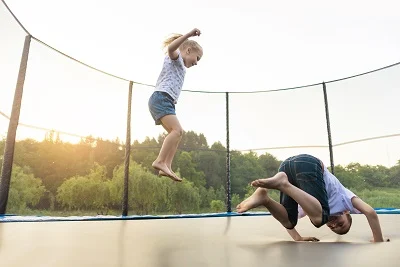Are Trampolines Safe for Kids? A Comprehensive Guide for Parents
Trampolines have long been a source of joy and excitement for children, providing hours of entertainment and physical activity. However, with their popularity comes significant safety concerns. As parents, understanding the risks associated with trampolines and how to mitigate them is crucial for ensuring our children’s safety while they have fun. In this blog, we’ll delve into expert advice, injury statistics, and practical safety tips to help you make informed decisions.
The Allure of Trampolines
Trampolines appeal to children due to the thrill of jumping and the sense of freedom they offer. The bounce, the air, and the ability to perform flips and tricks create an irresistible draw. However, as much fun as trampolines can be, they are not without risks.
Understanding the Risks
Research indicates that trampoline-related injuries are more common than many might think. The American Academy of Pediatrics (AAP) highlights that more than 800,000 children were treated for trampoline-related injuries between 2009 and 2018. While minor injuries such as bumps and bruises are common, serious injuries, including broken bones, sprains, and even concussions, pose significant risks.
Common Injuries
Injuries can range from minor cuts to serious conditions requiring medical attention. Here are some of the most common injuries associated with trampoline use:
- Fractures and Sprains: Many children suffer broken bones or ligament injuries from falls.
- Concussions: Collisions can lead to brain injuries with long-lasting effects.
- Spinal Injuries: Falls from the trampoline can lead to serious spinal cord injuries, potentially resulting in paralysis.
When Are Kids Most at Risk?
Injuries often occur under specific circumstances:
- Size Disparities: Smaller children jumping alongside larger ones face higher injury risks.
- Collisions: Jumpers colliding during play can lead to serious injuries.
- Improper Landing: Misjudging landings can result in falls from the trampoline surface.
- Risky Moves: Attempts at flips or somersaults increase the chance of accidents.
Expert Recommendations
To help parents navigate trampoline safety, the AAP offers several recommendations:
- Age Restrictions: Children under the age of 6 should not use trampolines. Young children are at a higher risk for serious injuries.
- Supervision: Always ensure an adult is present to monitor trampoline use.
- One at a Time: Limit the jumping to one child at a time to prevent collisions.
- Avoid Flips: Discourage flips and other stunts that can lead to severe injuries.
- Safety Equipment: If you own a trampoline, ensure it has proper safety pads, nets, and is positioned away from obstacles.
Choosing a Safe Environment
If you’re considering allowing your child to use a trampoline, think carefully about where they will be bouncing:
- Home Trampolines: If you opt for a backyard trampoline, install it as close to the ground as possible and check safety features regularly.
- Trampoline Parks: While they offer fun experiences, trampoline parks can be riskier due to the number of jumpers and the bounce levels. Ensure that your child is old enough and understands the risks before visiting.
Conclusion
Trampolines can be a fun and exciting way for kids to get exercise, but they come with inherent risks that every parent should be aware of. By understanding the potential dangers and implementing recommended safety measures, you can help your children enjoy bouncing while minimizing their risk of injury. Always prioritize safety and supervision, and encourage safe jumping practices. After all, a fun trampoline experience should not come at the cost of your child’s well-being.
Final Thoughts
In conclusion, while trampolines can provide endless fun, being informed and cautious is essential for keeping your kids safe. Always remember to stay close, monitor their jumping, and encourage safe practices.

